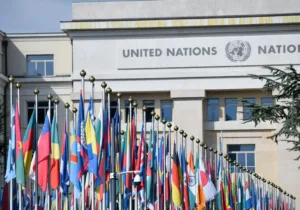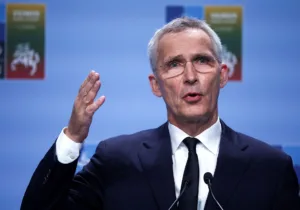Long-time neutrals Sweden and Finland appear poised to apply for NATO membership, perhaps as early as this month or during next month’s NATO summit. If these Nordic neighbors do join the alliance, this dramatic change in the European security landscape will be good for them—and for NATO.
Transformations
Considered by many a de facto member of NATO, Sweden was viewed as the more likely of the tandem to join the Atlantic alliance. After all, with its advanced military capabilities, Sweden has been a key contributor to post-Cold War NATO missions in Bosnia, Kosovo, Afghanistan, and Libya, as well as NATO’s training mission in Iraq. Even before the cataclysm Vladimir Putin unleashed on February 24, a sizable majority in the Swedish parliament expressed support for the so-called “NATO option.” By late 2020, national polls revealed a shift in Swedish public opinion in favor of NATO membership.
Finland, on the other hand, agreed to neutrality in 1948, which kept the Red Army at bay and kept Finland nominally independent throughout the Cold War. That agreement was replaced in 1992 by a treaty that’s silent on the issue of neutrality but instead declares that Russia and Finland “shall refrain from the threat or use of force against the territorial integrity or political independence of the other party” and “shall not use or allow the use of their territory for armed aggression against the other party.” This history helps explain Finnish reticence about NATO. Even after Putin’s string of aggression the past decade, support for NATO membership remained below 30 percent in Finland. However, Putin’s beastly assault on Ukraine altered the political calculus in Helsinki, increased public support for NATO membership to 68 percent, and accelerated the country’s transformation from neutral to NATO aspirant. Death and destruction on the doorstep have a way of focusing the mind.
Indeed, the Finns know well that just after Russia signed that 1992 treaty with Finland, it promised to “refrain from the threat or use of force” against Ukraine and respect Ukraine’s “independence… sovereignty and the existing borders.” The lesson for Finland, which, like Ukraine, shares a long border with Russia, is that treaties don’t matter to Putin. And so, Finland is galloping toward NATO membership—a stunning reversal from its position as recently as January. Finland’s parliament recently began debating NATO membership. Prime Minister Sanna Marin clearly supports it. Finland’s minister for European affairs calls NATO membership “highly likely.”
The fact that Finland is abandoning Finlandization and racing toward NATO speaks volumes—about NATO and Moscow.
None of this news about Finland’s transformation from reticent NATO outsider to enthusiastic NATO aspirant is to suggest that Sweden won’t join NATO. Swedish Prime Minister Magdalena Andersson “has made up her mind and wants Sweden to join NATO,” according to published reports. And her ruling party issued a statement in April declaring, “When Russia invaded Ukraine, Sweden’s security position changed fundamentally.” Yet after bombs started falling on Kyiv, there were initial plans for the two neighbors to “jump together.” While those plans appear to have been adjusted in recent weeks, there are strong indications that Sweden’s political leadership will press forward to close any daylight separating it from Finland’s suddenly pro-NATO leadership.
Whether together or separate—whether in June or later—the entry of Sweden and Finland into NATO seems to be a matter of when, not if. NATO Secretary General Jens Stoltenberg says Finland and Sweden would be “very much welcomed” in the alliance and would be accepted “in a relative quick way.”
In response to these reports, Putin’s regime unloaded a fusillade of rhetorical and literal military threats against the two Nordic nations, openly warning them not to join NATO. One can almost hear the Finns and Swedes respond, “Or else, what? You’ll invade?” Spurred by Putin’s wars in Georgia and Ukraine, the Finns and Swedes have concluded not just that they would be better off defending their territory, sovereignty, and freedom as members rather than mere neighbors of NATO—but that they will be safer from attack behind NATO’s shield than they will beyond it.
Benefits
By joining the alliance, Sweden and Finland will help themselves—and help NATO. Unlike some of the more recent additions to the alliance, Sweden and Finland will be net exporters of, and contributors to, security. Indeed, they check all the political, economic, military, and geographic boxes for NATO membership. As Adm. James Stavridis, former commander of NATO, puts it, “I always say to people in Sweden and Finland: If you want to join NATO, tell us on Wednesday and we’ll have you in by Friday. They’re that good.”
Sweden ranks in the top 25 on a global index of military capabilities. Swedish firms design and field some of the best weapons systems in the world, including many of the antitank weapons that are defending Ukraine from Putin’s army of looters and rapists. In addition, Sweden participated in NATO’s high-intensity, large-scale Cold Response exercise this year. In 2021, Sweden hosted the Arctic Challenge exercise, which brought together warplanes from Sweden and Finland, along with NATO members America, Denmark, Germany, the Netherlands, and Britain. In early 2020, US B-1B bombers joined Swedish fighters in maneuvers over Sweden. In late 2020, Swedish and US warships, Swedish fighter-bombers, and US fighter-bombers carried out combat maneuvers in and above the Baltic Sea. In 2018, US Marines deployed to Sweden for joint amphibious exercises. In 2017, more than 20,000 Swedish and American troops participated in the largest military exercise in Sweden in decades. The US Navy has tested itself against Sweden’s world-class submarines for years.
Plus, the Swedish government has approved a 40-percent increase in defense spending and deployed troops to Gotland (a Swedish island in the Baltic Sea that would be key to any NATO effort aimed at reinforcing or retaking Estonia, Latvia, or Lithuania).
Finland fields a stout military of 280,000 personnel and 900,000 reservists. Like Sweden, Finland participated in Cold Response and other allied exercises promoting interoperability. And as NATO documents detail, Finland has contributed to NATO-led operations in Bosnia, Kosovo, and Afghanistan. Finland also is a part of NATO’s strategic airlift initiatives; participates in NATO’s Cooperative Cyber Defense Center of Excellence; and provides logistical support to NATO forces based in or transiting through Finnish territory. Unlike Sweden, Finland invests 2 percent of GDP on defense—a standard NATO expects of all members. (Sweden in March announced plans to hit the 2-percent-of-GDP target.)
If/when they join the alliance, the security contributions of Sweden and Finland will be especially evident in the Baltic and Arctic regions. In the former, Finland and Sweden will significantly improve NATO’s strategic depth and deployment capabilities vis-à-vis Estonia, Latvia, and Lithuania. In the latter, the alliance will benefit from enhanced awareness of, capabilities along, and deterrence in what defense experts call the “High North.” Recall that Putin has been militarizing the Russian Arctic—and making outlandish claims in other parts of the Arctic—for more than a decade.
In short, NATO membership would provide Sweden and Finland with an insurance policy against Russian invasion. And their accession into NATO would represent a significant military and geographic benefit for the alliance—something NATO has needed since the Baltic states joined in 2004. The fact that NATO has deferred for decades to these two neighbors puts the lie to Putin’s—and his apologists’—fantasy version of history that claims NATO imposes its will on Eastern Europe. NATO’s growth spurts have never been about NATO “expanding” by pushing its way into Eastern Europe; rather, NATO’s growth has always been a function of sovereign nations seeking shelter by pushing their way into NATO. In other words, NATO grows not by conquest but by consent, not by the force of arms of its members but by the desire for security of its aspirants.
Gains
Discussing defense treaties, military deterrence, and troop deployments in a publication devoted to Christianity may seem incongruent to some readers. But it’s not incongruent if we recognize these as tools to prevent the kind of war that kills by the millions, the kind of war NATO has helped prevent for 73 years.
We will not know the biblical notion of peace—of shalom, peace with harmony and justice—until Christ returns to make all things new. In the interim, in a broken world full of broken men with grudges and grievances, there are no viable alternatives to military preparedness and defensive alliances like NATO—which, it pays to recall, was created not to wage war but to deter it. As NATO’s first secretary-general explained, “The paramount, the permanent, the all-absorbing business of NATO is to avoid war.”
Finland and Sweden will enhance NATO’s ability to do that. When they join NATO, the alliance will gain two members ready on Day One to contribute to the common defense. America will gain new allies equipped to export security throughout Europe and beyond. And Putin will gain lot more worries.






